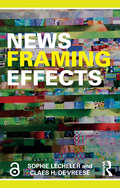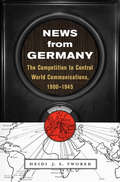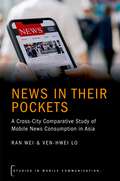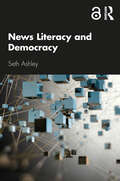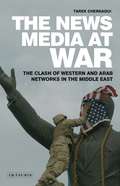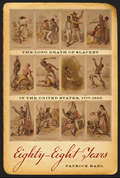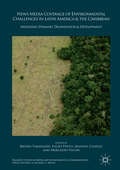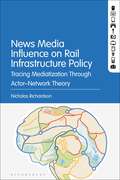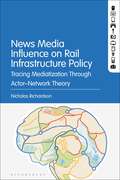- Table View
- List View
News Discourse: How News Organizations Create 'newsworthiness' (Continuum Discourse #45)
by Monika Bednarek Helen CapleThis book exploresthe role of language and images in newspaper, radio, online and televisionnews. The authors introduce useful frameworks for analysing language, image andthe interaction between the two, and illustrate these with authentic newsstories from around the English-speaking world, ranging from the Oktoberfest toenvironmental disasters to the killing of Osama bin Laden. This analysispersuasively illustrates how events are re-told in the news and made'newsworthy' through both language and image. This clearly written andaccessible introduction to news discourse is essential reading for students,lecturers, and researchers in Linguistics, Media/Journalism Studies, andSemiotics.
The News Event: Popular Sovereignty in the Age of Deep Mediatization
by Francis CodyIn the hypermediated world of Tamil Nadu, Francis Cody studies how “news events” are made. Not merely the act of representing events with words or images, a “news event” is the reciprocal relationship between the events being reported in the news and the event of the news coverage itself. In The News Event, Francis Cody focuses on how imaginaries of popular sovereignty have been remade through the production and experience of such events. Political sovereignty is thoroughly mediated by the production of news, and subjects invested in the idea of democracy are remarkably reflexive about the role of publicly circulating images and texts in the very constitution of their subjectivity. The law comes to stand as both a limit and positive condition in this process of event making, where acts of legal and extralegal repression of publication can also become the stuff of news about news makers. When the subjects of news inhabit multiple participant roles in the unfolding of public events, when the very technologies of recording and circulating events themselves become news, the act of representing a political event becomes difficult to disentangle from that of participating in it. This, Cody argues, is the crisis of contemporary news making: the news can no longer claim exteriority to the world on which it reports.
News Framing Effects: Theory and Practice
by Claes H. de Vreese Sophie LechelerNews Framing Effects is a guide to framing effects theory, one of the most prominent theories in media and communication science. Rooted in both psychology and sociology, framing effects theory describes the ability of news media to influence people’s attitudes and behaviors by subtle changes to how they report on an issue. The book gives expert commentary on this complex theoretical notion alongside practical instruction on how to apply it to research. The book’s structure mirrors the steps a scholar might take to design a framing study. The first chapter establishes a working definition of news framing effects theory. The following chapters focus on how to identify the independent variable (i.e., the "news frame") and the dependent variable (i.e., the "framing effect"). The book then considers the potential limits or enhancements of the proposed effects (i.e., the "moderators") and how framing effects might emerge (i.e., the "mediators"). Finally, it asks how strong these effects are likely to be. The final chapter considers news framing research in the light of a rapidly and fundamentally changing news and information market, in which technologies, platforms, and changing consumption patterns are forcing assumptions at the core of framing effects theory to be re-evaluated.
News Framing Effects: Theory and Practice
by Sophie Lecheler Claes H. de VreeseNews Framing Effects is a guide to framing effects theory, one of the most prominent theories in media and communication science. Rooted in both psychology and sociology, framing effects theory describes the ability of news media to influence people’s attitudes and behaviors by subtle changes to how they report on an issue. The book gives expert commentary on this complex theoretical notion alongside practical instruction on how to apply it to research. The book’s structure mirrors the steps a scholar might take to design a framing study. The first chapter establishes a working definition of news framing effects theory. The following chapters focus on how to identify the independent variable (i.e., the "news frame") and the dependent variable (i.e., the "framing effect"). The book then considers the potential limits or enhancements of the proposed effects (i.e., the "moderators") and how framing effects might emerge (i.e., the "mediators"). Finally, it asks how strong these effects are likely to be. The final chapter considers news framing research in the light of a rapidly and fundamentally changing news and information market, in which technologies, platforms, and changing consumption patterns are forcing assumptions at the core of framing effects theory to be re-evaluated.
News from Germany: The Competition to Control World Communications, 1900–1945 (Harvard historical studies ; #v. 190)
by Heidi J. TworekHeidi Tworek’s innovative history reveals how, across two devastating wars, Germany attempted to build a powerful communication empire—and how the Nazis manipulated the news to rise to dominance in Europe and further their global agenda. When the news became a form of international power, it changed the course of history.
News, Gender and Power
by Stuart Allan Gill Branston Cynthia CarterHow do gender relations affect the practice of journalism? Despite the star status accorded to some women reporters, and the dramatic increase in the number of women working in journalism, why do men continue to occupy most senior management positions? And why do female readers, viewers and listeners remain as elusive as ever? News, Gender and Power addresses the pressing questions of how gender shapes the forms, practice, institutions and audiences of journalism. The contributors, who include John Hartley, Pat Holland, Jenny Kitzinger and Myra Macdonald, draw on feminist theory and gender-sensitive critiques to explore media issues such as: * ownership and control* employment and occupation status* the representation of women in the media* the sexualization of news and audience research. Within this framework the contributors explore media coverage of: * the trial of O. J. Simpson* British beef and the BSE scandal* the horrific crimes of Fred and Rosemary West* child sexual abuse and false memory syndrome* the portrayal of women in TV documentaries such as Modern Times and Cutting Edge.
News, Gender and Power
by Cynthia Carter Gill Branston Stuart AllanHow do gender relations affect the practice of journalism? Despite the star status accorded to some women reporters, and the dramatic increase in the number of women working in journalism, why do men continue to occupy most senior management positions? And why do female readers, viewers and listeners remain as elusive as ever? News, Gender and Power addresses the pressing questions of how gender shapes the forms, practice, institutions and audiences of journalism. The contributors, who include John Hartley, Pat Holland, Jenny Kitzinger and Myra Macdonald, draw on feminist theory and gender-sensitive critiques to explore media issues such as: * ownership and control* employment and occupation status* the representation of women in the media* the sexualization of news and audience research. Within this framework the contributors explore media coverage of: * the trial of O. J. Simpson* British beef and the BSE scandal* the horrific crimes of Fred and Rosemary West* child sexual abuse and false memory syndrome* the portrayal of women in TV documentaries such as Modern Times and Cutting Edge.
News in their Pockets: A Cross-City Comparative Study of Mobile News Consumption in Asia (Studies in Mobile Communication)
by Ran Wei Ven-hwei LoSince the debut of the iPhone in 2007, the mobile phone has become a quick, convenient, and immensely popular gateway for accessing and consuming news. With three billion mobile phone subscribers, Asian countries have led this seismic shift in news consumption. They provide a wide range of opportunities to study how, as mobile technology matures and becomes routinized, mobile news is increasingly subject to societal constraints and impositions of political power that reduce the democratic benefits of such news and call into question the application of these technological innovations within governments and societies. News in Their Pockets explores the societal, technological, and user-related factors behind why and how digital-savvy college students seek news via the mobile phone across Asia's most mobile cities--Shanghai, Hong Kong, Singapore, and Taipei. Situating cross-societal comparative analyses of mobile news consumption in Asia within a digital and global context, this volume outlines the evolution of the mobile phone to its prominence in disseminating news, offers predictors of patterns in mobile news consumption, investigates user needs and expectations, and illustrates future impacts on civic engagement from mobile news consumption. By examining the interplay between game-changing and empowering communication technology and constraining social systems, News in Their Pockets provides the framework necessary for constructive, continuing debates over the promise and peril of digital news and exposes our underlying reasoning behind the adoption of the mobile phone as the all-in-one media of choice to stay socialized, entertained, and informed in the modern digital age.
NEWS IN THEIR POCKETS STMC C: A Cross-City Comparative Study of Mobile News Consumption in Asia (Studies in Mobile Communication)
by Ran Wei Ven-hwei LoSince the debut of the iPhone in 2007, the mobile phone has become a quick, convenient, and immensely popular gateway for accessing and consuming news. With three billion mobile phone subscribers, Asian countries have led this seismic shift in news consumption. They provide a wide range of opportunities to study how, as mobile technology matures and becomes routinized, mobile news is increasingly subject to societal constraints and impositions of political power that reduce the democratic benefits of such news and call into question the application of these technological innovations within governments and societies. News in Their Pockets explores the societal, technological, and user-related factors behind why and how digital-savvy college students seek news via the mobile phone across Asia's most mobile cities--Shanghai, Hong Kong, Singapore, and Taipei. Situating cross-societal comparative analyses of mobile news consumption in Asia within a digital and global context, this volume outlines the evolution of the mobile phone to its prominence in disseminating news, offers predictors of patterns in mobile news consumption, investigates user needs and expectations, and illustrates future impacts on civic engagement from mobile news consumption. By examining the interplay between game-changing and empowering communication technology and constraining social systems, News in Their Pockets provides the framework necessary for constructive, continuing debates over the promise and peril of digital news and exposes our underlying reasoning behind the adoption of the mobile phone as the all-in-one media of choice to stay socialized, entertained, and informed in the modern digital age.
News Literacy and Democracy
by Seth AshleyNews Literacy and Democracy invites readers to go beyond surface-level fact checking and to examine the structures, institutions, practices, and routines that comprise news media systems.This introductory text underscores the importance of news literacy to democratic life and advances an argument that critical contexts regarding news media structures and institutions should be central to news literacy education. Under the larger umbrella of media literacy, a critical approach to news literacy seeks to examine the mediated construction of the social world and the processes and influences that allow some news messages to spread while others get left out. Drawing on research from a range of disciplines, including media studies, political economy, and social psychology, this book aims to inform and empower the citizens who rely on news media so they may more fully participate in democratic and civic life.The book is an essential read for undergraduate students of journalism and news literacy and will be of interest to scholars teaching and studying media literacy, political economy, media sociology, and political psychology.
News Literacy and Democracy
by Seth AshleyNews Literacy and Democracy invites readers to go beyond surface-level fact checking and to examine the structures, institutions, practices, and routines that comprise news media systems.This introductory text underscores the importance of news literacy to democratic life and advances an argument that critical contexts regarding news media structures and institutions should be central to news literacy education. Under the larger umbrella of media literacy, a critical approach to news literacy seeks to examine the mediated construction of the social world and the processes and influences that allow some news messages to spread while others get left out. Drawing on research from a range of disciplines, including media studies, political economy, and social psychology, this book aims to inform and empower the citizens who rely on news media so they may more fully participate in democratic and civic life.The book is an essential read for undergraduate students of journalism and news literacy and will be of interest to scholars teaching and studying media literacy, political economy, media sociology, and political psychology.
The News Machine: Hacking, The Untold Story
by James HanningThere is one mystery figure at the heart of 'Hackergate' -Glenn Mulcaire, the News of the World's top private investigator. The former AFC Wimbledon footballer has never spoken publicly or in court about his work investigating and backing up front-page news stories (such as the News of the World's award-winning David Beckham scoop). Mulcaire's arrest in 2006 for intercepting royal-household phone messages barely registered at the time. Yet his work has continued to generate headlines and embarrassment for the establishment -with a Prime Minister on the back foot after his former aide Andy Coulson was sentenced on 4 July 2014 to 18 months in prison. Mulcaire is the insider whose testimony is essential for grasping how far the media rot has spread through Britain. James Hanning, deputy editor of the Independent on Sunday has investigated the story from the beginning, questioning key players - from reporters to Andy Coulson himself. For The News Machine he gained exclusive access to Mulcaire and his family - who are deriving no financial benefit from this book - over an extended period of time, and interviewed senior politicians, policemen, lawyers and journalists who were involved. The News Machine is the first complete look at the sharp edge of our daily news. How did the police and the press regulator fail to find the truth? How did the News of the World protect its criminal hierarchy with lies, threats, and money? How did the royals and our government get caught up in the cover up?
The News Media: What Everyone Needs to Know® (What Everyone Needs To Know®)
by C.W. Anderson Leonard Downie Michael SchudsonThe business of journalism has an extensive, storied, and often romanticized history. Newspaper reporting has long shaped the way that we see the world, played key roles in exposing scandals, and has even been alleged to influence international policy. The past several years have seen the newspaper industry in a state of crisis, with Twitter and Facebook ushering in the rise of citizen journalism and a deprofessionalization of the industry, plummeting readership and revenue, and municipal and regional papers shuttering or being absorbed into corporate behemoths. Now billionaires, most with no journalism experience but lots of power and strong views, are stepping in to purchase newspapers, both large and small. This addition to the What Everyone Needs to Know® series looks at the past, present and future of journalism, considering how the development of the industry has shaped the present and how we can expect the future to roll out. It addresses a wide range of questions, from whether objectivity was only a conceit of late twentieth century reporting, largely behind us now; how digital technology has disrupted journalism; whether newspapers are already dead to the role of non-profit journalism; the meaning of "transparency" in reporting; the way that private interests and governments have created their own advocacy journalism; whether social media is changing journalism; the new social rules of old media outlets; how franchised media is addressing the problem of disappearing local papers; and the rise of citizen journalism and hacker journalism. It will even look at the ways in which new technologies potentially threaten to replace journalists.
News Media and EU-China Relations (The Palgrave Macmillan Series in International Political Communication)
by L. ZhangAn exploration of the role of the news media in the development of EU-China relations after the end of the Cold War, this book provides empirical evidence to support what Nye and Anholt have argued: that branding a country's image is soft power. The author examines the nature of European Union and China coverage in Chinese and European news media respectively and explores how the economics, politics, and journalistic practice interplay in shaping the coverage. Based on this analysis, the author delves into the relationship between the news media and their foreign policy toward each other in terms of both the general direction of policy-making and the policy in a specific issue area. Including not only content analysis of media coverage, but also has first-hand interview materials with the officials involved in the decision-making process and the journalists involved in reporting the EU and China, the book sheds light on the way in which the media construct the post-Cold War world and therefore play a role in transforming international relations.
The News Media at War: The Clash of Western and Arab Networks in the Middle East (PDF)
by Tarek CherkaouiTarek Cherkaoui reveals how geo-political and ideological legacies of the past, which divide the world into a dichotomy of 'us' against 'them', play a dominant role in reinforcing the ensuing polarisation of our media.
The News Media At War: The Clash of Western and Arab Networks in the Middle East
by Tarek CherkaouiTarek Cherkaoui reveals how geo-political and ideological legacies of the past, which divide the world into a dichotomy of 'us' against 'them', play a dominant role in reinforcing the ensuing polarisation of our media.
The News Media At War: The Clash of Western and Arab Networks in the Middle East (Library of Modern Middle East Studies #Vol. 125)
by Tarek CherkaouiDuring the 2003 War in Iraq, American news media found it difficult to convey their pro-war perspective outside the United States. Since the war was unpopular in many parts of the world, failure to win hearts and minds - particularly in the Middle East - represented a significant setback for the American soft power.
News Media Coverage of Environmental Challenges in Latin America and the Caribbean: Mediating Demand, Degradation and Development (Palgrave Studies in Media and Environmental Communication)
by Bruno Takahashi Juliet Pinto Manuel Chavez Mercedes VigónThis edited collection provides a unique survey of the ways in which news media organizations across Latin America and the Caribbean cover global, regional and local environmental issues and challenges. There is growing recognition within academia, governments, industries, NGOs and civil society about the importance of strategic communication and the news media in informing current societal and policy discussions about environmental issues. With this in mind, this volume explores the content of reporting as well as the structural and individual contests faced by media organizations and journalists, with a focus on the very unique political, social, cultural and environmental conditions that affect the countries individually. The book provides a survey of the most relevant and current environmental issues that have attracted public attention across the region and within countries in Latin America and the Caribbean in the first part of the 21st century.This volume will be of interest to students, instructors and researchers interested in Latin America and the Caribbean, media and the environment.
News Media in the Arab World: A Study of 10 Arab and Muslim Countries
by Barrie Gunter Roger DickinsonNews Media in the Arab World: A Study of 10 Arab and Muslim Countries is based on ongoing research at the Department of Media and Communication, University of Leicester, and has investigated the rapidly changing nature of the news media in Arab countries. They have investigated the role of newspapers and television in news provision and the impact of new media developments, most especially the emergence of the internet as a platform for news distribution and of international satellite television channels such as Al Jazeera. Examining the constantly developing nature of news, the collection contains separately authored chapters produced by the researchers responsible for each original analysis, covering Bahrain, Egypt, Iraq, Kuwait, Libya, Oman, Qatar, Palestine, Saudi Arabia and the United Arab Emirates. Based on original primary and secondary research, this will be the first empirical-based collection to blend perspectives from both the Western and Arab nations.
News Media in the Arab World: A Study of 10 Arab and Muslim Countries
by Barrie Gunter Roger DickinsonNews Media in the Arab World: A Study of 10 Arab and Muslim Countries is based on ongoing research at the Department of Media and Communication, University of Leicester, and has investigated the rapidly changing nature of the news media in Arab countries. They have investigated the role of newspapers and television in news provision and the impact of new media developments, most especially the emergence of the internet as a platform for news distribution and of international satellite television channels such as Al Jazeera. Examining the constantly developing nature of news, the collection contains separately authored chapters produced by the researchers responsible for each original analysis, covering Bahrain, Egypt, Iraq, Kuwait, Libya, Oman, Qatar, Palestine, Saudi Arabia and the United Arab Emirates. Based on original primary and secondary research, this will be the first empirical-based collection to blend perspectives from both the Western and Arab nations.
News Media Influence on Rail Infrastructure Policy: Tracing Mediatization Through Actor–Network Theory
by Nicholas RichardsonIn this book, Richardson's research spans a decade and two cities - Sydney, Australia and Montreal, Canada - focusing on three metro-style rail infrastructure case study projects: one ongoing, one failed and one upgraded after reaching fifty years of age – to build an irrefutable case that the news media is highly influential to policy, and that these influences are complex, messy and changing.News Media Influence on Rail Infrastructure Policy offers scholars and industry practitioners in the arenas of policy analysis, politics and media communications a method for astutely guiding large-scale projects through the complex and changing landscape of 24/7 news media. It is underpinned by empirical research that identifies and endeavors to close a considerable gap in current understanding and practice. This gap represents a failure to recognise and respect mediatization – the many powerful influences impacting a policy arena that has drawn the ire of the news media. The result of this failure is ineffective communication that does little to advance the policy piece and, in the worst instances, leads to policy immobilisation or poor policy decision-making.Drawing significantly on Actor–Network Theory, Richardson identifies the influential actors and alliances at play when policy is subjected to media discourse, and he proposes a framework for tracing and managing them. In doing so, he demonstrates that such a framework is not only vital for the successful negotiation of policy and projects in the media, but also to an (r)evolutionary recasting of public, expert and media actors in the development and decision-making process.
News Media Influence on Rail Infrastructure Policy: Tracing Mediatization Through Actor–Network Theory
by Nicholas RichardsonIn this book, Richardson's research spans a decade and two cities - Sydney, Australia and Montreal, Canada - focusing on three metro-style rail infrastructure case study projects: one ongoing, one failed and one upgraded after reaching fifty years of age – to build an irrefutable case that the news media is highly influential to policy, and that these influences are complex, messy and changing.News Media Influence on Rail Infrastructure Policy offers scholars and industry practitioners in the arenas of policy analysis, politics and media communications a method for astutely guiding large-scale projects through the complex and changing landscape of 24/7 news media. It is underpinned by empirical research that identifies and endeavors to close a considerable gap in current understanding and practice. This gap represents a failure to recognise and respect mediatization – the many powerful influences impacting a policy arena that has drawn the ire of the news media. The result of this failure is ineffective communication that does little to advance the policy piece and, in the worst instances, leads to policy immobilisation or poor policy decision-making.Drawing significantly on Actor–Network Theory, Richardson identifies the influential actors and alliances at play when policy is subjected to media discourse, and he proposes a framework for tracing and managing them. In doing so, he demonstrates that such a framework is not only vital for the successful negotiation of policy and projects in the media, but also to an (r)evolutionary recasting of public, expert and media actors in the development and decision-making process.
News Media Innovation Reconsidered
by María Luengo Susana Herrera-DamasA guide to journalistic ethics for today’s digital technologies With contributions from an international panel of experts on the topic, News Media Innovation Reconsidered offers a guide for the revitalizing of the ethical and civil ideals of journalism. The authors discuss how to energize journalistic practices and products and explore how to harness the power of digital technological innovations such as immersive journalism, the automatization and personalization of news, newsgames, and artificial-intelligence news production. The book presents an innovative framework of “creative reconstruction” and reviews new journalistic concepts, models, initiatives, and practices that clearly demonstrate professional ethics that embrace truth seeking, transparency, fact checking, and accuracy, and other ethical considerations. While the contributors represent numerous countries, many of examples are drawn from the Spanish-speaking media and can serve as models for an international audience. This important book: Explores the impact on the news media from mobile-first, virtual reality, and artificial intelligence-driven platforms Examines the challenges of maintaining journalistic ethics in today’s digital world Demonstrates how to use technology to expose readers to news outside their comfort zones Provides information for discerning truth from fake news Written for researchers, students in journalism and communication programs, New Media Innovation Reconsidered offers a much-needed guide for recreating journalistic ethics in our digital age.
News Media Innovation Reconsidered: Ethics and Values in a Creative Reconstruction of Journalism
by María Luengo Susana Herrera-DamasA guide to journalistic ethics for today’s digital technologies With contributions from an international panel of experts on the topic, News Media Innovation Reconsidered offers a guide for the revitalizing of the ethical and civil ideals of journalism. The authors discuss how to energize journalistic practices and products and explore how to harness the power of digital technological innovations such as immersive journalism, the automatization and personalization of news, newsgames, and artificial-intelligence news production. The book presents an innovative framework of “creative reconstruction” and reviews new journalistic concepts, models, initiatives, and practices that clearly demonstrate professional ethics that embrace truth seeking, transparency, fact checking, and accuracy, and other ethical considerations. While the contributors represent numerous countries, many of examples are drawn from the Spanish-speaking media and can serve as models for an international audience. This important book: Explores the impact on the news media from mobile-first, virtual reality, and artificial intelligence-driven platforms Examines the challenges of maintaining journalistic ethics in today’s digital world Demonstrates how to use technology to expose readers to news outside their comfort zones Provides information for discerning truth from fake news Written for researchers, students in journalism and communication programs, New Media Innovation Reconsidered offers a much-needed guide for recreating journalistic ethics in our digital age.
NEWS MEDIA WENK C: What Everyone Needs to Know® (What Everyone Needs To Know®)
by Leonard Downie Michael Schudson C.W. AndersonThe business of journalism has an extensive, storied, and often romanticized history. Newspaper reporting has long shaped the way that we see the world, played key roles in exposing scandals, and has even been alleged to influence international policy. The past several years have seen the newspaper industry in a state of crisis, with Twitter and Facebook ushering in the rise of citizen journalism and a deprofessionalization of the industry, plummeting readership and revenue, and municipal and regional papers shuttering or being absorbed into corporate behemoths. Now billionaires, most with no journalism experience but lots of power and strong views, are stepping in to purchase newspapers, both large and small. This addition to the What Everyone Needs to Know® series looks at the past, present and future of journalism, considering how the development of the industry has shaped the present and how we can expect the future to roll out. It addresses a wide range of questions, from whether objectivity was only a conceit of late twentieth century reporting, largely behind us now; how digital technology has disrupted journalism; whether newspapers are already dead to the role of non-profit journalism; the meaning of "transparency" in reporting; the way that private interests and governments have created their own advocacy journalism; whether social media is changing journalism; the new social rules of old media outlets; how franchised media is addressing the problem of disappearing local papers; and the rise of citizen journalism and hacker journalism. It will even look at the ways in which new technologies potentially threaten to replace journalists.


